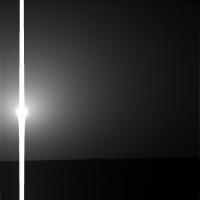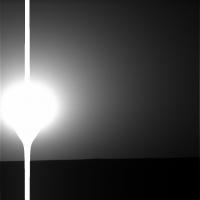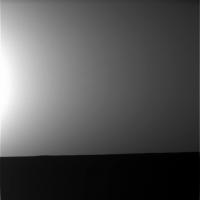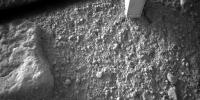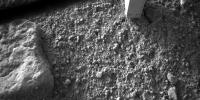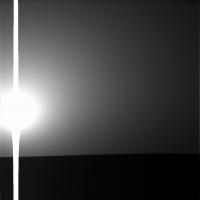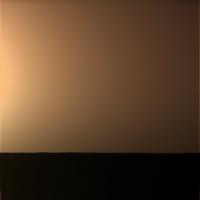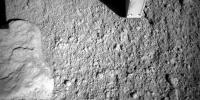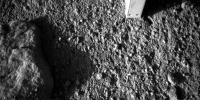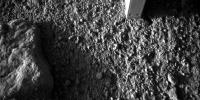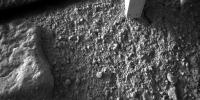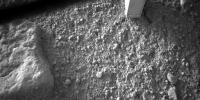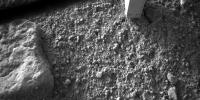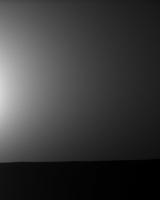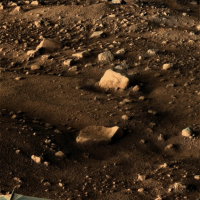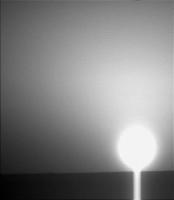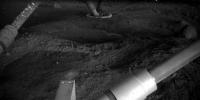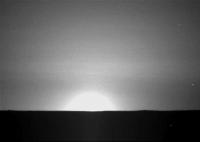Printable Version of Topic
Click here to view this topic in its original format
Unmanned Spaceflight.com _ Phoenix _ Late 'night' Phoenix Observations.
Posted by: 3488 Jul 12 2008, 08:55 PM
Hi everyone.
Phoenix on Sol 46 have returned images of the Sun above the Northern Horizon, just before midnight.
Sun 11:14 PM local time.
Sun 11:16 PM local time.
Sun 11:26 PM local time.
Andrew Brown.
Posted by: Stu Jul 12 2008, 09:10 PM
Thanks!
I know that's just a big flarey... flare above a block of black, but boy, do I love that top image...!!! ![]()
Posted by: 3488 Jul 12 2008, 09:29 PM
I know that's just a big flarey... flare above a block of black, but boy, do I love that top image...!!!
Hi Stu,
Yes I know, I do not think there is much that can be done about the 'blooming', part of the problem with using CCDs in high contrast conditions, but yes, I agree, I too love that top image. Suspect the top image was a shorter exposure.
Also RAC image @ 11:29 PM Sol 46. Note how different the illumination is.
As above but on Sol 47 @ 12:07 AM.
Sun above horizon: Sol 47 @ 12:29 AM local time.
Andrew Brown.
Posted by: Stu Jul 12 2008, 10:56 PM
IF those three images in today's release actually are R, G & B images, and IF I've got my colour balance right, then here's a colour view of Phoenix's night sky...
Posted by: 3488 Jul 12 2008, 11:19 PM
Thank you very much Stu.
Yes IMO that is pretty well spot on. Just checked again on the U of A site, but there is nothing new. Perhaps in the next download? It's great to see these near midnight observations.
Andrew Brown.
Posted by: imipak Jul 13 2008, 07:57 AM
Thanks Stu and all, that's a keeper. I love such simple, almost abstract images where the power comes from the context.
At some point as the season changes there will be prolonged semi-sunsets, hopefully the CCD bleed problem will be mitigated somewhat - I'd love to see something like the Oppy "sunset at Meridiani" image, or even a simulated multiple exposures shot compiled over many days -- something like, say, http://www.eaglestation.com/sunsets/620-2197.jpg .(That's just a random pick from a quick google.)
Posted by: 3488 Jul 13 2008, 08:25 PM
Hi imipak, what you suggested with the Midnight Sun montage you linked to, is exactly what I have already suggested to the Phoenix team.
Thought this may be interesting to share.
Changing illumination during half a sol 46 - 47 from the RAC, local time, Scandia Colles.
12:09 Hrs Sol 46.
19:25 Hrs Sol 46.
20:45 Hrs Sol 46.
22:36 Hrs Sol 46.
23:20 Hrs Sol 46.
00:06 Hrs Sol 47.
00:58 Hrs Sol 47.
Andrew Brown.
Posted by: djellison Jul 13 2008, 08:49 PM
There's no need to fill the UMSF server by downloading and then attaching all the Phoenix imagery in question - simply provide links to it at the Phoenix website.
Posted by: slinted Jul 14 2008, 04:37 PM
Here's an little preview of what I think we'll see in the midnight sun images, once we see an official release. What I did isn't accurate. Frankly, it's completely made up. I even left in the rainbow of CCD bleed as a reminder of how not-real it is. I tried to match the look of the http://apod.nasa.gov/apod/ap050620.html, but since the brightness and 'blue-ness' of the halo are dependent on dust levels, it may end up looking completely different (did I mention the image is made up? ![]() ). I can't wait to see what the SSI team can do with them. This view will be as awe inspiring and (hopefully) popular as the now iconic Spirit image.
). I can't wait to see what the SSI team can do with them. This view will be as awe inspiring and (hopefully) popular as the now iconic Spirit image.
http://www.lyle.org/~markoff/processed/SS046EFF900334030_15230RC.jpg
Posted by: djellison Jul 14 2008, 07:39 PM
And it's very pretty
Posted by: Paul Fjeld Jul 15 2008, 04:08 AM
Changing illumination during half a sol 46 - 47 from the RAC, local time, Scandia Colles.
I really don't understand why the shadows, which are very distinct during the day, should be so washed out at midnight. Is the sky that much more lit up by a low sun? Is there a good deal of backfill lighting by the midnight facing surfaces of Phoenix... (no). Very odd and disturbing for a guy who has been trying to paint that scene for the last month (with little success).
Paul
Posted by: CosmicRocker Jul 15 2008, 04:32 AM
I suspect that if you were to look at the exposure lengths of those images, you would find that the "shutter" remained open longer when there was less light.
Posted by: fredk Jul 15 2008, 03:38 PM
I noticed that too. The ratio of scattered light (via the sky) to direct sunlight is much higher when the sun is close to the horizon, because the air is so dusty, and low sunlight must pass through lots of dust. Think of the dust storm last year - there was so much dust that shadows became much less distinct for the rovers, even at midday.
On earth you can see the same effect, but it's less noticable on clear days because on earth more of the scattered light is from air molecules than dust. Think of a smoggy or smoky day on earth.
Posted by: Ant103 Jul 15 2008, 04:03 PM
Hi,
Here is a try to make a mosaic with the two frames to have the midnight's sun. Removed manually CCD flare.
http://www.db-prods.net/blog/wp-content/uploads/2008/07/midnightsunsol47-coul.jpg
Posted by: Paul Fjeld Jul 15 2008, 04:14 PM
Okay, that makes sense. I would have thought it would have been like the Opportunity low sun anyway - perhaps even more pronounced. The midnight shots are maybe a little more exposed, but I don't think so much that it would wash out a shadow line completely, especially since the lit parts aren't blown out. The anti-sun sky must be bright too then!
Paul
Posted by: Paul Fjeld Jul 16 2008, 03:05 AM
I'm trying to suss out the anti-sun sky near midnight and I'm not sure if I'm interpreting some of the 'blocky' SSI pics right. From Mark's site, SOL 49, http://www.met.tamu.edu/mars/i/SS049ESF900517560_15683L3M1.jpg is a view straight at the sun at 1:00am. http://www.met.tamu.edu/mars/i/SS049ESF900519701_156A3L5M1.jpg was taken about a half hour later about 20 degrees east of anti-sun. To my eye, the at-sun shot gross variations in value compare reasonably well with the high rez pic gradations taken earlier. It's filter was L3 450.8 (solar/dust). The second picture, taken through the L5 887.0 filter (solar/dust+water), seems to indicate that the sky brightens as elevation >increases<. At least me looking at a 'lego block tower' shot with fredk's take on the lack of shadows in the RAC midnight pics in my head, makes me think that's what I'm looking at. Is the data too skimpy? (What, 15 pixels ...?) Anybody see what I'm seeing? Should I read up on filters?
Paul
Posted by: 3488 Jul 19 2008, 04:10 PM
Hi all,
I have worked on this image, with contrast & a little cropping, centreing the Due North point.
Looking Due North @ 11:09 PM / 23:09 local time in Scandia Colles.
North Pole is approx 1,303 KM / 809 miles straight up the centre. Sun is off to the left.
Andrew Brown.
Posted by: Paul Fjeld Jul 23 2008, 03:28 AM
Huzzah! Near http://www.met.tamu.edu/mars/i/SS056EFF901136427_16350RAM1.jpg (+13 min) pics! Also from http://www.met.tamu.edu/mars/i/SS056EFF901145183_16360RAM1.jpg am and http://www.met.tamu.edu/mars/i/SS056EFF901152094_16380RAM1.jpg am.
Weird shadow action - washed out at low sun, more distinct as the sun rises. Still can't figure out the sky stuff anti-sun but it must be brighter at midnight.
My attempt at a color shot: http://www.pfinspace.com/phoenix/PFMarsMidnight.jpg.
http://www.pfinspace.com/phoenix/PFMarsMidnight.jpg.
I don't know what the 2-Blue filter does to the final colors instead of the surface C-Blue filter. Anyway. Hope the official color one comes out soon!
Paul
Posted by: Stu Jul 23 2008, 07:21 AM
I had a go at animating colourised versions I made of that scene...
"Midnight Shadows"... ![]()
Posted by: Ant103 Jul 23 2008, 02:03 PM
Nice gif Stu ![]()
Here is my version in a board ![]() .
.
http://www.db-prods.net/blog/wp-content/uploads/2008/07/planchevariationshoraires-sol55-56.jpg
Posted by: ElkGroveDan Jul 23 2008, 03:33 PM
Are those anything like "http://www.lyricsfreak.com/c/cat+stevens/moonshadow_20028197.html"? (maybe it's time for some of your verse, Stu.)
Posted by: Gray Jul 23 2008, 07:34 PM
Thanks Ant. I like the side-by-side comparison.
Posted by: mars loon Jul 23 2008, 09:15 PM
Midnight Sun from Phoenix
http://phoenix.lpl.arizona.edu/images/gallery/md_15233.jpg
just appeared at UA website:
"The solar images were taken between 10 p.m. and 2 a.m., local solar time, during the nights of sols 46 to 56. composite of Sols 46 to 54"
Posted by: Stu Jul 23 2008, 09:20 PM
Awwwwwwwwww, sooooooooooooooooooo cool!!!! I have waited a long, long time to see that! ![]()
Posted by: 3488 Jul 23 2008, 09:35 PM
Same here, in fact it was something I requested prior to Phoenix's arrival. Thank you so very much guys for bringing that here & for continuing the discussion.
I thought that this would make for an interesting subject & pleased by the response at UMSF, that I was not deluded or wrong.
Thank you all for welcoming me back, I was a little nervous at first, but I am amongst friends here & it shows.
Andrew Brown.
Posted by: fredk Jul 24 2008, 12:30 AM
Very cool midnight sun composite. Interesting to have a sort of "through the welder's glass" view, with everything so dark that the sun's disk is visible without glare/overexposure. I wonder if any attempt was made to provide correct relative intensity of the foreground/sky and suns, or if it was just done "aesthetically". The solar disks in the image are dimmer near midnight, more or less as I'd expect. But my guess is that the foreground (from Peter pan) is somewhat too bright. It would be nice to see a (necessarily faked) more traditional midnight sun composite as well, with the foreground and sky fully exposed and brighter solar disks. (Of course the Peter pan was shot afternoon-ish, so the shadows wouldn't be right...)
Posted by: Astro0 Jul 24 2008, 01:34 AM
I'm working on it - the still and the movie! ![]()
Astro0
Posted by: imipak Jul 24 2008, 07:40 PM
Wow, exactly what I was thinking of! (post #6) As I began by admiring Stu's colourisation for a couple of minutes before flipping to the previous tab with the release image, the greys appeared a beautiful pale blue/green before my colour balance adjusted... powerfully atmospheric, like a half-remembered dream of a misty moonlit night.
It brings back and old day-dream... carpet Mars with a few dozen very cheap, simple, "nothing but images" devices. I know, I know, there are dozens of reasons it can't be done, not least the very limited science return vs the cost. *sigh*
EDIT: Astro0 - looking forward to that immensely!
Posted by: Stu Jul 24 2008, 09:21 PM
Thanks
Posted by: Astro0 Jul 24 2008, 11:15 PM
For the Midnight Sun film I'm working on...
OK tell me which is correct - the Sun moving from left to right or right to left?
The panorama always confuses me for which is N,S,E,W. At least I know which is up and down ![]()
Astro0
Posted by: fredk Jul 25 2008, 12:07 AM
Left to right. In the southern hemisphere it'd be the other way around...
Posted by: 3488 Jul 25 2008, 07:30 AM
That's correct.
The 10:00 PM / 22:00 position is on the left, the 2:00 AM / 02:00 Hrs position on the right. Midnight dead ahead. That montage covers a 4 hour sweep, though spread out over 11 sols.
Andrew Brown.
Posted by: Astro0 Aug 6 2008, 01:00 PM
Belatedly, here's a movie depicting Phoenix's midnight sun.
http://www.speedyshare.com/329960127.html (22.7mb)
or a very small preview version Midnight_Sun_sml.wmv ( 835.52K )
: 847
Midnight_Sun_sml.wmv ( 835.52K )
: 847
Remember it's done as an artist's view, not the pure science.
I leave that stuff to the smart people on the forum.
Enjoy
Astro0
Posted by: Pertinax Aug 6 2008, 01:13 PM
Appropriately, that is a work of beauty Astro0! Wow -- Thank you!!!
-- Pertinax
Posted by: nprev Aug 6 2008, 01:19 PM
Outstanding, Astro0, really!!!! ![]()
Posted by: TheChemist Aug 6 2008, 01:23 PM
I would add a second Oscar for the music, which was also exquisite !
Fantastic work Astro0, thank you !
Posted by: Astro0 Aug 6 2008, 01:36 PM
Thanks all.
Getting an Oscar was always a childhood dream of mine.
I can't lay claim to the music though. It comes from an online free music source, where you can use pieces for not-for-profit efforts. I thought it was appropriate, giving a lonely, desolate feel to the scene.
Appreciate all the feedback.
Astro0
Posted by: Ant103 Aug 6 2008, 02:07 PM
GREAT! ![]()
I imagine that it represente a big job to make a so beautiful scenery ![]() .
.
Posted by: ElkGroveDan Aug 6 2008, 02:12 PM
Just wow! I want to see it in Imax.
Posted by: mike Aug 7 2008, 02:22 AM
I enjoyed that myself. Somehow seeing the sun and the dimming and brightening of the ambient light make Mars that much more real. Thank you.
Posted by: ollopa Aug 7 2008, 02:38 AM
Very Cool - I loved the moving tell-tale!
BTW: if anyone wants to create a tell-tale emoticon, I'd love to use it in all sorts of settings!
Posted by: Astro0 Aug 7 2008, 03:42 AM
 Something like this?
Something like this?
I'm sure one of the technically minded Admin people could accommodate the request.
Astro0
Posted by: nprev Aug 7 2008, 03:46 AM
Man...talk about mad skills!!! ![]() Astro0, you just don't cease to amaze. I want that emoticon!!!
Astro0, you just don't cease to amaze. I want that emoticon!!!
Posted by: 3488 Aug 17 2008, 10:14 AM
Hi everyone,
Nice observation.
http://phoenix.lpl.arizona.edu/images.php?gID=21570&cID=226.
I have cropped & enlarged the central due north position of said image.
1,303 Km / 809 miles to the North Pole on mars.
Andrew Brown.
Posted by: belleraphon1 Aug 17 2008, 03:48 PM
Remember it's done as an artist's view, not the pure science.
I leave that stuff to the smart people on the forum.
Enjoy
Astro0
Boy, am I behind... (so much going on hard to keep up... ain't that great
Beautiful movie.... watched it for the first time today.
One of my cats, Hansel, was in my lap. When the music started her head darted up and she watched the scene intently, then slowly moved out of my lap onto the pc table and tried to tap the moving sun image of the pc screen. So, she loved it too!!!!
Thanks Astro0... definite keeper!!!
Craig
Posted by: AndyG Aug 18 2008, 12:58 PM
Once the sun properly sets at this latitude, there's chances to see Phobos rising to a (bizarre) couple of degrees above the horizon - I wonder if we'll see any imagery of it?
Andy
Posted by: jmknapp Aug 18 2008, 02:46 PM
Did you have specific dates that would be good? I just ran a quick check & it looks like Phobos max elevation for any given pass ranges from 0-1.5 degrees, so there has to be the coincidence of a "high" elevation when the sun is set. For example, on Sept. 15 Phobos rises just 0.1 deg when the sun is 0.9 deg below the horizon. On Nov. 19 Phobos rises 1.4 deg with the sun 7.1 deg below the horizon. At least that's what my software says.
Posted by: Paul Fjeld Sep 2 2008, 08:55 PM
At http://phoenix.lpl.arizona.edu/images/gallery/lg_26263.jpg! Late night shot through the legs of Phoenix by the RAC. This one was taken at 2:09 am when the sun was about 3 degrees above the horizon (according to Starry Night...), so it is near to what we might have seen had they taken the shot in the week after landing. Eerie having little shadow - so the sky is brightly lit by the low sun, but the sun's direct light is attenuated so much that what shadow it casts is washed out? The http://phoenix.lpl.arizona.edu/images/gallery/lg_26269.jpg shots, taken two hours later, show more distinct shadows with the sun about 11 degrees up.
Neat pictures. Look forward to the color views our bright members will make... ![]()
Posted by: Paul Fjeld Sep 2 2008, 09:08 PM
Didn't see it earlier, but the RAC took http://phoenix.lpl.arizona.edu/images/gallery/lg_26260.jpg one through the legs at 10:30pm on SOL 96 with the sun about 1 1/2 degrees up. Very eerie...
Posted by: Stu Sep 2 2008, 09:27 PM
Cute little animation here on my Gallery page if anyone wants a look...
http://phoenixpics.wordpress.com/2008/09/02/shadows-shifting-under-phoenix
Posted by: Paul Fjeld Sep 3 2008, 12:07 AM
Very cool Stu!
I thought those were RGBs so a color shot could be attempted, but can't suss out the UA lg#s.
BTW: did the question of frost on the gear strut ever get "resolved"? The low light in these shots makes it look like those are big clumps sticking to the gear. My current wondering is if the heat of the engines didn't warm up the dust so that it got a bit sticky, just like the rasp maybe heated up the ice samples and gave them some stick. Then the question of frost - the clumps look lighter - gets answered, how? That north gear is mostly shadowed so the metal keeps colder than the surface and the frost can stick around?
Posted by: slinted Sep 3 2008, 12:17 AM
They were RGB-lit, but from what I could see, the lights didn't brighten up the scene enough to make a color image. The ambient light is just too bright for the colored lamps to make a significant contribution (at least to the level of detail visible in the raw images).
Posted by: Paul Fjeld Sep 3 2008, 12:59 AM
Oh, right. The RAC doesn't have filters - just the lights.
Posted by: Gray Sep 3 2008, 01:09 PM
Those images look to me like flash photos taken inside a cave. Very cool.
Posted by: 3488 Sep 6 2008, 07:27 PM
It is very cool,
Also this @ 22:30 LMST on Sol 96. Holy Cow in complete shade.
Andrew Brown.
Posted by: imipak Sep 7 2008, 11:27 AM
Nice image, 3488. The more time passes, the more the spotty leg puzzles me. I've not seen any suggested mechanisms that account for three key features (as I remember them, happy to be corrected!):
1. The phenomena is only apparent on one leg, of three;
2. The "spots" were apparent in the first post-landing images, but their apparent size and density increased in the first couple of weeks on the surface;
3. The existing lumps don't appear to have continued growing as the sun sinks lower in the sky and (presumably) local surface temperatures decrease; they reached their current state and stopped.
Dust and soil blown around at landing time, perhaps with a thin melted surface film of water, was been the proposed mechanism that most appealed to me, but it doesn't seem to account for points (1) and (2).
What have I missed?
Posted by: 3488 Sep 7 2008, 11:35 AM
Hi imipak,
My guess is that the sublimation has ceased from Holy Cow & Snow Queen.
I think that you are correct linking the cessation of the growth of the globules on the leg with the lowering Sun.
'Night time' temperatures have lowered on average 5 C / 9 F since the Solstice & that is maybe enough to make the difference. Either way, the end game for Phoenix is drawing closer now but hopefully, she will survive to mid - late November when solar conjunction is nearing & power levels will be desperate.
We are already seeing daily morning H2O frosts now, maybe in the shadows persisting into the afternoons.
Below I've cropped & enlarged the Sun just beneath the horizon on Sol 101 @ 01:23 HRS LMST.
Andrew Brown.
Posted by: centsworth_II Sep 7 2008, 03:24 PM
It's strange, and irritating, that the strut close to the camera is pristine, while those intriguing splotches absolutely cover the more distant leg, too far away to get a good look.
Posted by: Paul Fjeld Sep 7 2008, 06:30 PM
I think the interference between the jet plumes and the surface being not homogenous might have made the dust spray in an interesting fashion. It's neat the way the dust piles up in drifts on the boundaries of the "competing" plumes and I wonder if there might not have been some of the spray that got kicked up that little hill, into the underside/radar of the lander, then fell back on that leg strut. Still wonder if the stuff was sticky 'cause it got heated by the jets, somewhat like the RAC's rasping friction heat, and has stayed stuck.
Powered by Invision Power Board (http://www.invisionboard.com)
© Invision Power Services (http://www.invisionpower.com)
